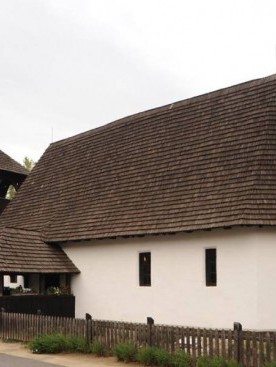The Calvinist Church – TákosTákos is one of the small villages situated on the hills along the river Tisza, in the Bereg historical and geographical region. Its very famous monument is the church built on the highest point of the settlement, which is also a masterpiece of 18th century popular architecture. Its old church was built probably on the very same place, since it was mentioned in 1733 that the village had a small wooden church, covered with shingle. The first, eastern part of the present church was built in 1766, and its was extended later in westward direction in 1784. The church is built on a wooden frame and its walls are made of sticks covered on both sides with clay and mud (‘patics’). The foundation is made of wooden beams having diameters between 40 to 45 centimetres. Holes have been carved in these beams in order to insert the poles supporting the walls. Afterwards, pickets were added and sticks were woven around these pickets to cover them in the end with mud mixed with chaff. In 1948, the flood toppled the belfry situated on the western side of the church, but the villagers re-erected it. Reconstruction of the church started in 1961. Damaged wooden structures have been repaired or restored, new webs of sticks were made and the mud walls were remade as well. New shingles were also placed on the roof. The eastern end of the church is enclosed by three sides of an octagon. Five small rectangular windows were cut through its southern and eastern walls. There is an open, wooden narthex in front of the entrance. The coffered wooden ceiling consists of 58 painted panels. This painted wooden ceiling is a masterpiece of popular art and was made – as one of the panels also attests – by Ferenc Lándor Asztalos. All panels are decorated with floral motifs, however, the decorations of all individual panels are different. This ceiling is in fact the church’s pride. It must be mentioned that guild regulations prescribed that all panels had to bear different patterns. The hexagonal pulpit bears floral motifs, too, and is also the work of Ferenc Lándor Asztalos, who painted it in 1766. The balustrade of the gallery reserved for unmarried men, that is, of the western gallery, is composed of 15 panels and according to its inscription it was painted in 1779. Opposite to the pulpit, one can see the bench reserved for the patrons of the church. Its balustrade is divided into three parts and was ordered by the noble Dancs family in 1867. The front side of the balustrade bears floral motifs being thus in harmony with the rest of the painted surfaces of the church. In its present state, the church in Tákos, called also ‘the barefooted Notre Dame’, is together with the church in Csaroda a special attraction of the Bereg region and represents in a unique manner the church architecture of small villages. |





















